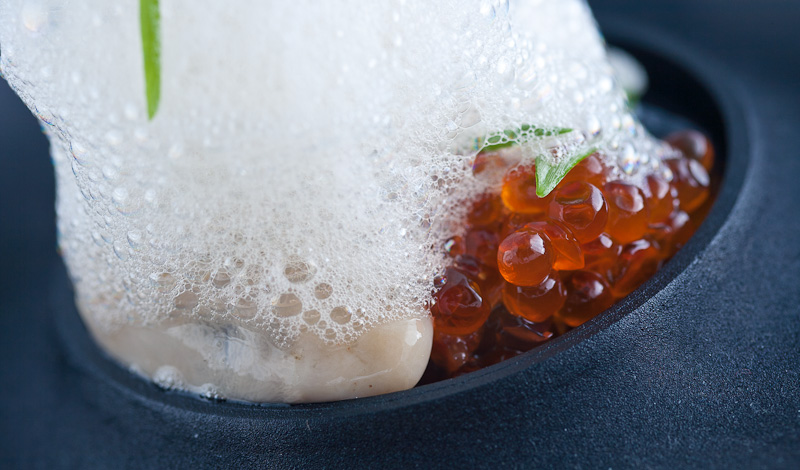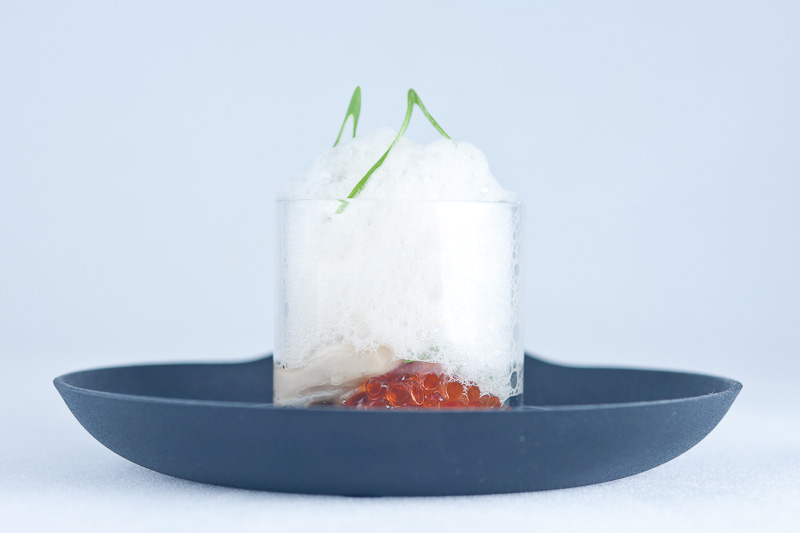
I mentioned in my last post that in buying Brooke Trout roe from BLiS, I also ordered smoked and natural steelhead roes. There’s one recipe in the book that makes use of the natural steelhead roe, so I decided to hit that one next. In this dish, the roe is paired with freshly-shucked and trimmed oysters, soft chunks of ginger gelee, scallion strips, and beer foam.
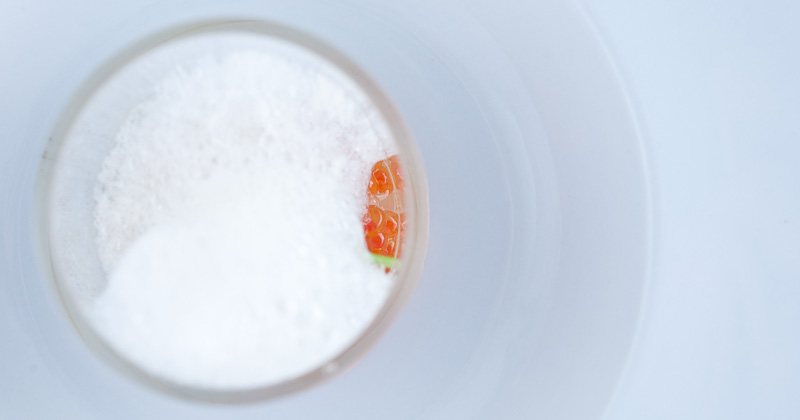
I bought several roes mainly to consolidate on the very expensive shipping that’s involved in getting them to California. I’m starting to suspect this wasn’t a great tactical move. Though the roes are stamped with a ‘use by’ date that’s still several weeks away, I’m pretty sure you want to use them as soon as you can.
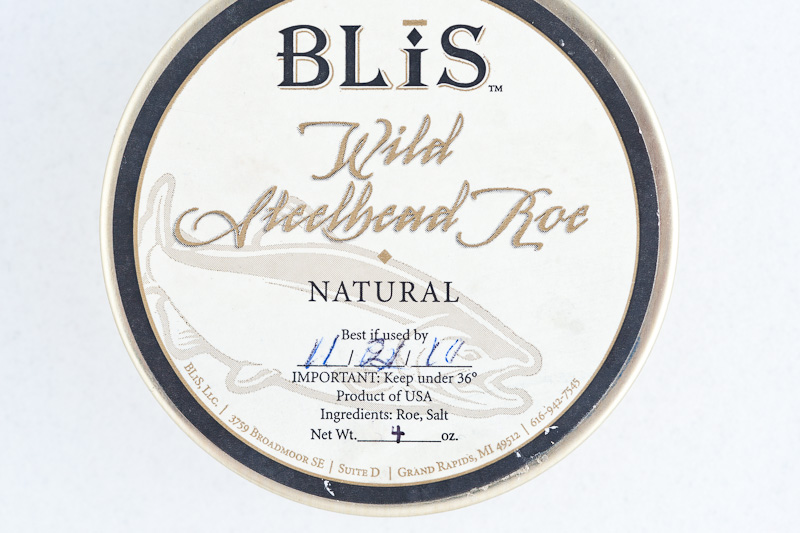
I’m keeping the roes in the bottom drawer of my fridge, aka the Meat Drawer. I’ve found that things sometimes ice over in this drawer; beers froth furiously after spending an afternoon there, and meat gets very rigid an solid there. I guess this is a good thing? It’s clearly very cold, so I’ve kept the roe sandwiched between two cold packs that they came shipped with in this drawer. Something I’ve noticed in both of the roes so far is the eggs, though beautiful, have a slightly ‘saggy’ quality to them. It’s not awful, but definitely noticeable, especially in close-up photos. Photos in the Alinea book don’t really show this, so I was curious if this is just a natural thing that happens the further the eggs move from superfresh, if I’m inadvertently damaging them in some way, or if this is how they’re meant to look.
By the same token, because I’m also not super-experienced tasting roe I’m not confident I could detect any subtle flaws in the flavor; these just tasted “really good” to me. The flavor here is very salty and very fishy; the best adjective I could think of would be “powerful”. They taste powerfully fishy in a very delicious way.
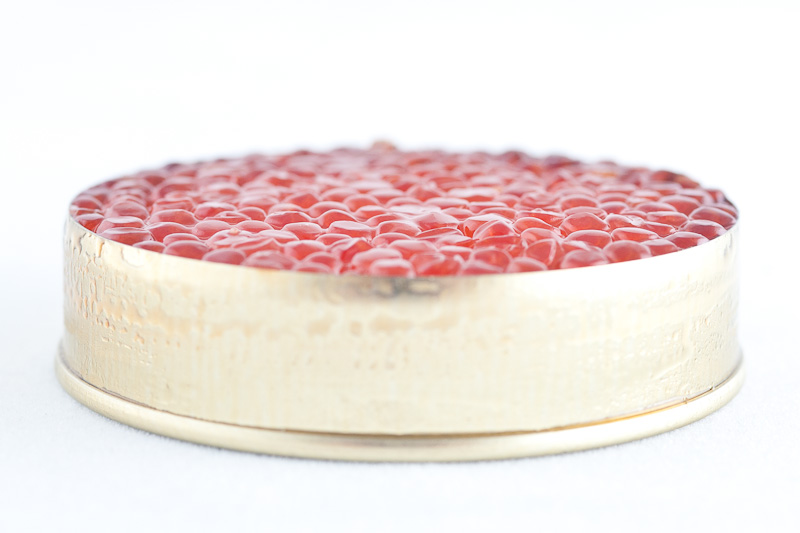
Last year I called around a few local fish markets and found one that sells steelhead roe in the winter months. I noted this in my cookbook when deciding to wait to do this one when it got cooler. My insistence on going the BLiS route is because the restaurant holds their products in such high regard that I really want to experience it myself, but the ‘saggy’ issue makes me wonder if there’s something to be said for buying local. To try to find some answers to these questions, I went back to Monterey Fish Market to see if they had any fresh steelhead roe. Unfortunately they did not, but I took the opportunity to ask them some questions, and when I got home I did a bit of research to pad out the information they gave me.
The word “caviar”, depending on national guidelines, can refer either specifically to cured sturgeon roe or (more generally) cured fish roe of any kind. The fishmongers at Monterey Fish said that when they get orders in of “salmon roe”, it’s usually by the skein (the entire sac of eggs found in the fish), and they sell it fresh (uncured). Even though I kept saying “steelhead roe”, they kept saying “salmon roe”, which I thought was odd until I got home, did some research, and found that “salmon” is not a specific species of fish, but rather a common name for several species of fish that share the common lifecycle of migration from freshwater to sea water and back again. So, steelhead roe is a type of salmon roe. I asked if the roe they sold was specifically cured, and they were clear that it was not; that I would need to cure it myself. I asked if the curing process was necessary, and they said they didn’t think one wanted to ever eat raw salmon roe because of parasite infections and possible health hazards.
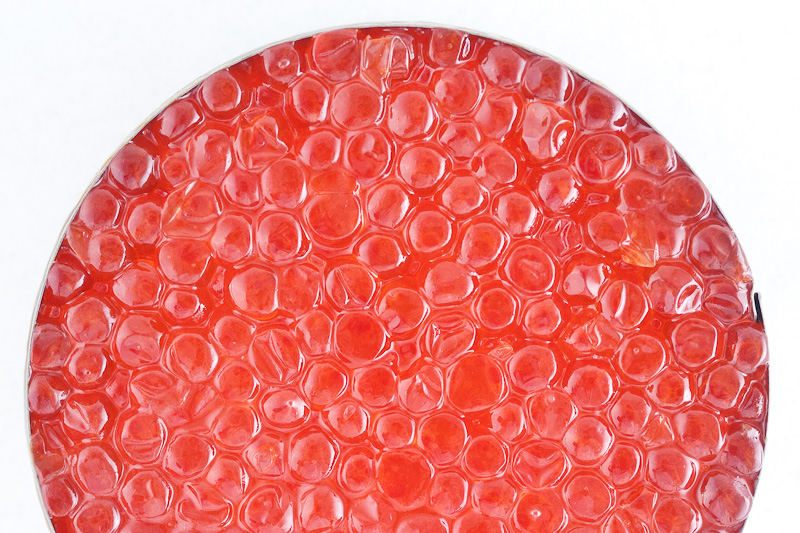
I described to them the ‘sag’ of my eggs that I’d ordered; that they tasted very nice but were just a little ‘floppy’. One of the fishmongers said salmon roe weren’t quite as round and tight as other caviar, but also noted that if I was buying something in a can that had traveled a long distance, that was likely the cause of the softness. I asked if the curing process caused the sagging and he said he didn’t think so.
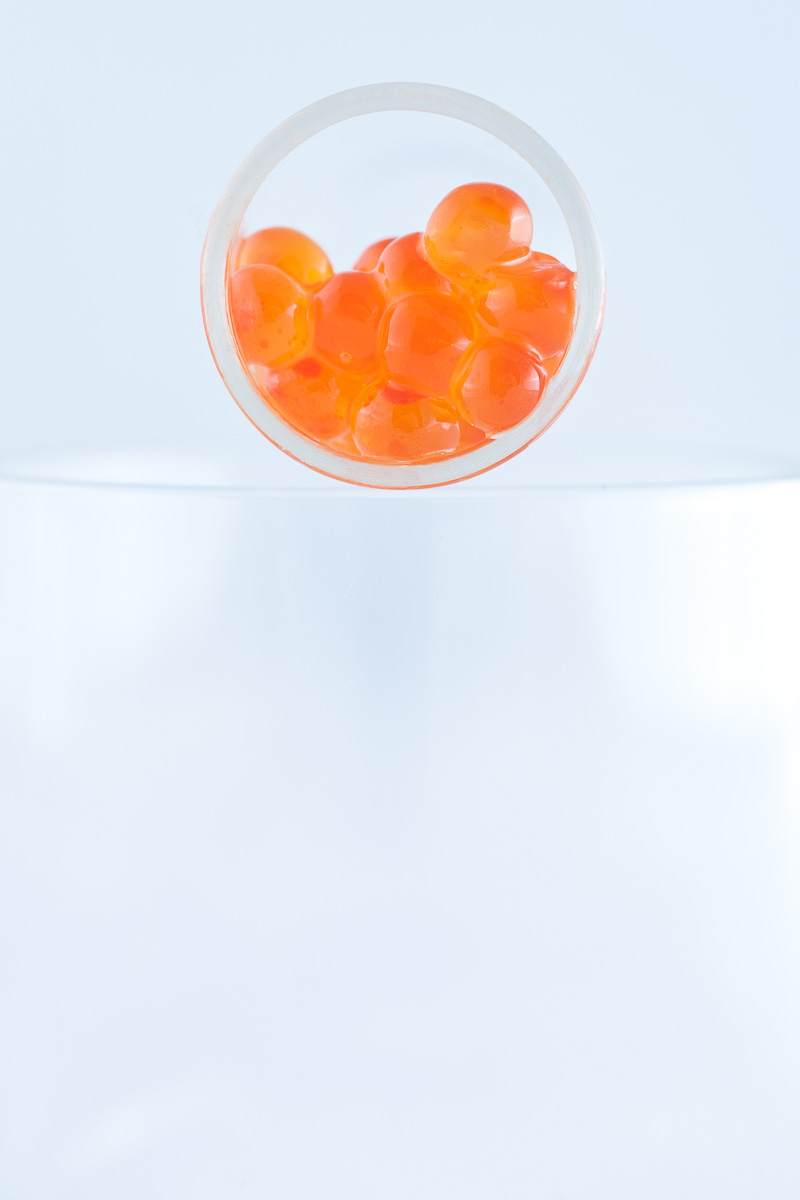
I searched more when I got home, and came across this (and many other) description of the curing process. What was most-interesting to me were the photos, in which we can see very taut, plump, round spheres of freshly-cured eggs:
http://www.homebrewchef.com/curingsalmonroe.html
This, to me, suggests that while my eggs are still perfectly delicious, the sagging I’m noticing is most-likely indicative of a slight lack of freshness. This is fine for a home chef. Pretty deluxe, even, as they’re extremely tasty. But ultimately they’re not ‘perfect’, and little things like this are a big deal in a high-end restaurant. I imagine Alinea, being so close to BLiS itself, can get first pick of their absolute freshest batches. Realizing this is a little frustrating; even going to the lengths of special-ordering this stuff can’t mirror the experience of having it in the restaurant itself. It’s awesome but not 100% awesome, and it’s the attempt at 100% awesome that’s the fun part for me. I’m not sure what the greater awesomeness is: using proper BLiS roe in a slightly-marred state or trying to cure my own to a degree that matches BLiS’ ideal.
Obviously, there’s only one way to find out.
I left my name and number at Monterey Fish Market and asked them to call me if they got in any fresh any steelhead roe. The idea of curing it myself is potentially not only a severe deviation from an ingredient Alinea would deem worthy of use, but also a little intimidating (I have little idea how to deal with a processed tin of salmon roe, much less how to safely cure some myself). But, if I hear back from them, I intend to try.
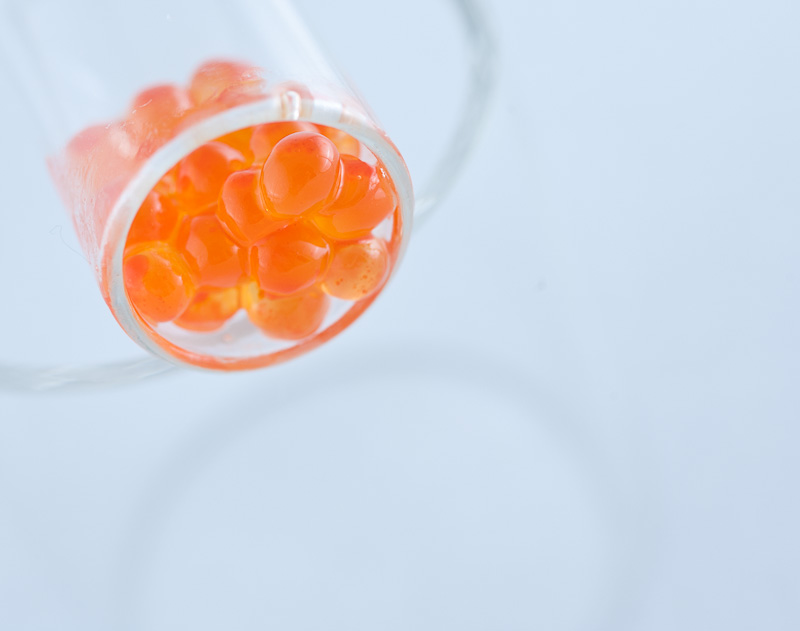
For this dish, however, I pressed on. I’d already bought the BLiS roe, so clearly I needed to put it to good use. Several spoonfuls of it went to the good use of me eating it straight from the tin. Then I got busy shucking some oysters, which I have to admit at this point that I’m damn good at. We have several oyster shucking knives from our trips to Tomales Bay, and I ripped through a dozen oysters in no time flat. I bought my oysters from Berkeley Bowl; they had some familiar-looking ones from Drake’s Bay, but the butcher who was helping me suggested I might also try some nearby smaller ones from Canada. “They’re more flavorful and less sandy” she said. So I got 6 of each. She turned out to be right; the smaller oysters were very delicate and buttery, and I preferred the size of them to the massive Chicken McNugget-sized Drake’s Bay offerings.
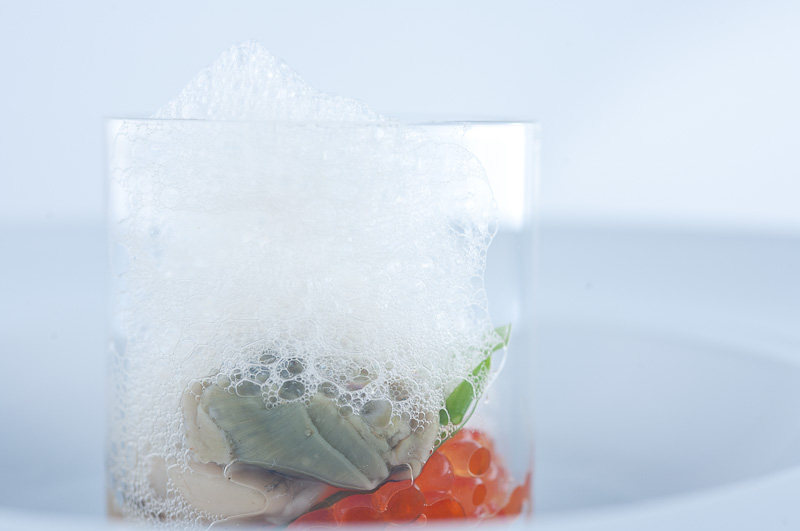
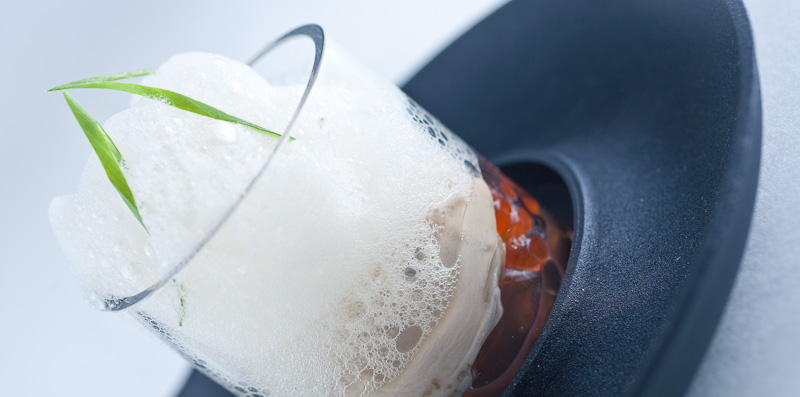
The components are layered in a glass sleeve I had custom-made at Adams-Chittenden, a scientific glass manufacturer I found in Berkeley. They’re super-lovely to work with and helped guide my decisions when trying to figure out measurements for the sleeves. Tableside the glass is lifted and the contents spill out into the bowl in which the course is served. At the bottom are walnut-sized chunks of ginger gelee, followed by a nice spoonful of the BLiS roe. Then in went a few oysters, some scallion slices, and the whole collection is topped with beer foam.
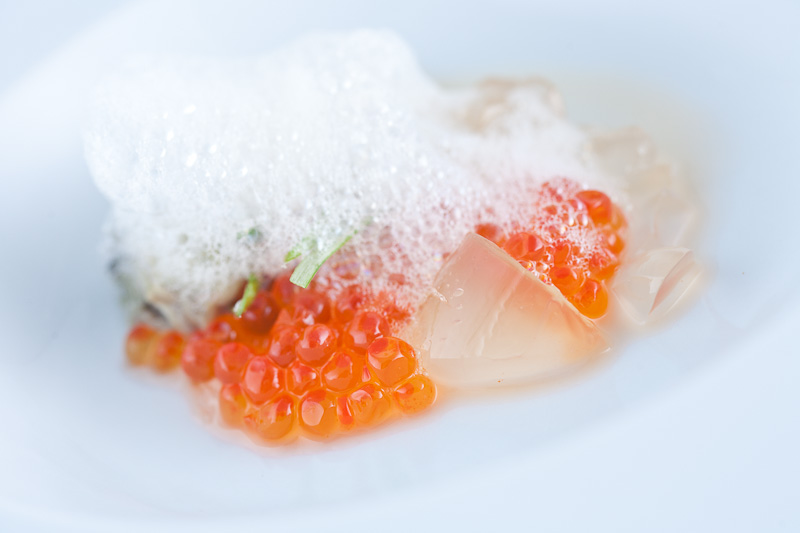

I loved the overall taste of this. I’ve written multiple times here about the awesomeness that is Tomales Bay; we went there for my birthday this year in fact, and gorged ourselves on fresh oysters, hot sauce, and beer. Oysters and sturgeon caviar is a very traditional pairing, so twisting that a little to highlight the steelhead roe isn’t terribly unusual, and the luxurious creaminess of the oysters and fishy saltiness of the roe are lovely together. I particularly liked the taste of the two against the scallion and ginger; the ginger chunks had plenty of ginger flavor but were also a bit spicy, so they were a little like a fancier version of the Tabasco hot sauce I usually top my oysters with. And the beer foam is another pretty obvious pairing with the oyster. For this foam I used a Drake’s 1500 IPA, which turned out to be just a hair too hoppy for me, and the recipe itself calls for quite a bit of sugar in it. Next time I’d halve the sugar and use something simple like a Coors, because that’s what I’d consider to be the most perfect oystering beer anyway.
